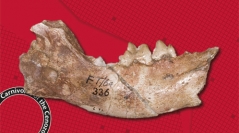

 Geodiversitas
41 (6) - Pages 267-283
Geodiversitas
41 (6) - Pages 267-283Fort Ternan is a middle Miocene (c. 13.7-13.8 Ma) site famous for its fossils of Kenyapithecus wickeri Leakey, 1962, considered the earliest African hominoid. Herein, the Carnivora and Hyaenodonta from this site are described and placed in their temporal context, showing the middle Miocene to be a time of transition from archaic carnivores of the early Miocene and carnivores of more modern aspect from the late Miocene. Fort Ternan includes: Amphicyonidae represented by ?Myacyon peignei n. sp., a new form distinguished by its hypercarnivorous m1, P4 with large protocone shelf, and M1 with reduced lingual shelf; Barbourofelidae, represented by a derived form; Percrocutidae, represented by abundant material of Percrocuta tobieni Crusafont & Aguirre, 1971; Viverridae, represented by the paradoxurines Kanuites lewisae Dehghani & Werdelin, 2008, and cf. Orangictis Morales & Pickford, 2005, and a putative viverrine; and Hyaenodonta represented by the teratodontine Dissopsalis pyroclasticus Savage, 1965 and a very large hyainailourine. This assemblage is a melange of forms harkening back to the early Miocene (the Hyaenodonta and Amphicyonidae), an evolving, still extant lineage (Viverridae), and more typical late Miocene forms (derived Barbourofelidae and Percrocutidae).
Middle Miocene, Carnivora, Hyaenodonta, Africa, Kenya, new species